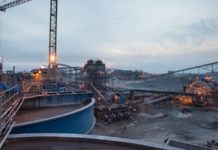[miningmx.com] — IT’S not been the happiest time for Lonrho’s share price since I wrote about it 14 months ago (14 June 2007). Since a bull phase peaked at 1000c last October, it’s fallen 60% to 400c/share and is 31% lower over the past 12 months.
In British pounds the fall is less steep, from a peak of 49p to 25p – but even that’s 22% down on the 32p of last June. When executive chairman David Lenigas moved in (in late 2005) it was 17p.
Still, Lenigas and CEO Geoff White were as bullish as ever when I met them recently. “In July we raised £19,8m through issuing shares at 26p,” says Lenigas. “Following £24,5m raised in February – through a share issue at 43p – that shows even in current conditions we have no difficulty in finding capital.”
He adds that 70% of new money still comes from the United States, where investors remain bullish about Africa’s long-term prospects.
Over the past year Lonrho has spun off two new companies. London AIM- and Aussie-listed Nare Diamonds, of which it last year acquired 24%, has been renamed Lonrho Mining and set off on the expansion trail.
Last month it announced an option to sell its 80% of the Schmidtsdrift diamond prospect in South Africa’s Free State to New Africa Mining for US$13,35m, to reinvest the net proceeds of $6m (after debt repayments and other items) in the “world-class” Lulo venture in Angola.
Lonrho owns 40% of Lulo and the Angolan government, which in July gave the project its approval, the other 60%, through state-owned Endiama. The $6m from Schmidtsdrift will exactly fund Lonrho Mining’s first-year exploration commitment.
And late last year it floated LonZim on AIM after raising £29,2m through a share issue at 100p (it’s now 95p). Lonrho will retain a 20% carry in LonZim and also earn fees. LonZim’s mandate is to invest in Zimbabwe and Mozambique’s Beira corridor. It’s already acquired controlling interests in automated payment firm Paynet, security printer Celsys and a hotel property for re-development in Beira.
With typical exuberance, Lenigas claims that by year-end – thanks to oil – Equatorial Guinea will have the world’s highest per capita income. He says Africa will use its oil wealth more sensibly than did the Middle East, where all the benefits flowed to a tiny layer of autocrats. However, in Africa oil belongs to the state. While there may be considerable corruption, far more of its proceeds will go into infrastructure and social development.
Lenigas also asserts that Angola is turning into a “proper democracy” with no real tribal issues. “It’s already producing more oil than Nigeria and will outstrip South Africa as the regional powerhouse within five years.”
The next most promising country is the ex-Portuguese colony on the other side of Africa, Mozambique, site of the last surviving asset of the old Lonrho, Maputo’s Cardoso Hotel. That’s being refurbished and now runs at 80% capacity.
Mozambique is also the location of the first plant of one of the ventures Lenigas waxed lyrical about last year: bottled water. It has a capacity of 400 000 l/month. There’s also a 22% interest in a plant in Congo (Kinshasa), and plants are being built in Luanda (5m l/month), Lubumbashi (1,3m l/month) and Johannesburg (1,2m l/month), which should come on stream in second quarter 2009. Thereafter, it’s planned to roll out facilities throughout Africa.
There’s also been good progress on the other business Lonrho was dipping its toes into a year ago: aviation. Fly540 Kenya went into profit in December and now carries around 20 000 passengers/month in peak months. It’s about to expand to Zimbabwe and is thought to have its eye on Angola, Ghana, Djibouti and Mozambique.
Other acquisitions include Kwikbuild (low-cost housing) in South Africa, Cape Town-based scheduled containerised shipping line SA Independent Liner Services (Sails), which is to be renamed Lonrho Shipping, and Rollex, which sources fresh fruit, vegetables and fish in southern Africa and sells, among others, to Marks & Spencer, Tesco and Sainsbury in Britain and Woolworths in South Africa.
And we mustn’t forget the Luba Freeport project in Equatorial Guinea, where about $60m has been invested so far.
In July, Collins Stewart, stockbroker to Lonrho and which makes a market in the share, published a detailed note on Lonrho. It projected it would record its first profit – of 4,3p/share – in the financial year to September 2010, rising to 6,3p in 2011, with “significant further upside”.
Taking 2011 as a good yardstick to value the business portfolio, and discounting back to 2008 at a rate of 20%, Collins Stewart valued Lonrho (then, as now, 25p) at 56p and recommended buying at up to 55p/share.
Though that may be a house view it does suggest anybody who has lost money buying the stock over the past six months should hold on rather than cut their losses.










